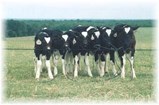Cloning Can Reverse Aging?

There were several differences in the approach taken by the two groups, and it's not clear at present which, if any, are responsible for the different outcomes. Recall that Dolly was created from mammary cells that were arrested in culture prior to being transplanted. In the ACT experiments, fibroblasts from a fetal cow were aged in culture until they reached replicative senescence before being used in nuclear transfer experiments.
The ACT group reconstructed almost 2,000 blastocysts with nuclei from senescent fibroblasts, from which six viable calves were born. The first hint that the cells from these calves were not aged was the high level of an mRNA associated with young cells (early population doubling level cDNA-1 or EPC-1). Levels of EPC-1 RNA in four of the cloned calves was higher than age-matched controls, and higher even than early passage fetal bovine cells. To see if this was a reflection of increased proliferative potential, fibroblasts were removed from an aborted cloned fetus made from senescent cells, and cell doublings recorded. They found that cells from the clone underwent an extraordinary 96 cell doublings in culture.

But perhaps the most extraordinary result of all was the finding that telomeres were actually longer in the cloned calves than in age-matched controls and even newborn calves. While bovine nucleated blood cells, the cell type analyzed for telomere length, have variable telomere lengths to begin with, their technique allowed them to observe a gradual shortening of telomere length with age—in the order of 20 to 100 bases per year.
"The significance of this finding is that you can, in essence, reset the aging clock in animal cloning, a development which overturns a previous obstacle to effective cloning. The study establishes a basis for far more kinds of cloning experiments that could have significant implications in medicine and agriculture," said Vince Cristofalo of the Lankenau Institute, co-author of the study.
So what's the difference here? Why do cloned cows grow younger as cloned sheep grow older? Or do they? It remains to be seen what telomere length has to do with lifespan in either case. However, even absent a connection to lifespan, the results reported here suggest that cloning doesn't necessarily rob cells of normal lifespan. In addition, this approach could be used to expand the proliferative potential of specific cell types, a trick that might come in handy in tissue engineering studies.
For more information: Robert Lanza, Advanced Cell Technologies, One Innovation Dr., Worcester, MA 01605. Email: rlanza@advancedcell.com.
By Laura DeFrancesco
